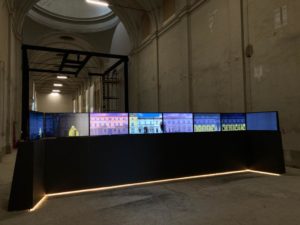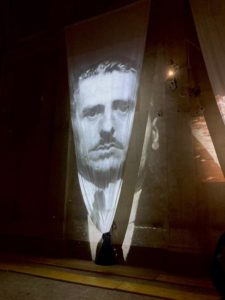One of the many victims of the Coronavirus, Parma Capitale 2020, started with great enthusiasm in January and immediately crushed by the lockdown, now, like the phoenix, is resurrected, resuming with enthusiasm as Parma Capitale della Cultura 2020+21 (Parma Capital of Culture 2020 + 21). And among the most important initiatives is the renovation of the Hospitale (a place of care, solidarity, hospitality, shelter since the thirteenth century), a gigantic building made in the shape of a Latin cross that is rethought as a space for culture. Studio Azzurro has been entrusted with the task of telling the story with a huge installation that accompanies us on this path of discovery. “Hospitale, Il Futuro della Memoria (the Future of Memory)”, created with the contribution of the Cariparma Foundation, launches the many initiatives in the coming months.
The exhibition is developed in four chapters:
Via d’Azeglio, the ancient Via Emilia allows only a glimpse of the facade. Studio Azzurro offers us a video of the front facade as if there were a square in front of it. At the entrance we find the reproduction of the front facade of the hospital as it appears in the Sanseverini watercolor and completed with current images. The story of a day, the night with a medieval procession and small screens featuring individual characters including the Verdian Violet.
The second installation is the one that concerns the place where the Altar once again stood with four semi-transparent wings, in tulle, in the center of the space, just under the dome, in order to be able to attend mass simultaneously from the four arms of the building. And four sheets, arranged at the corners of the intersection of the arms, on which are reproduced the silhouettes of the four statues that were positioned there, now in the National Gallery, which will be replaced there, (La Compassione, L’Aiuto, La Carità, L’Amore per il prossimo).
Then we have the Witness which is the space of the central nave with the video installation that celebrates the memory of the Oltretorrente district and the Old Hospital. A series of eight synchronized video projections on large sheets that initially represent large waterfalls, (allusion to the floods happened in 1177, 1414, 1868: the history of Parma is dotted with floods ….) tell the story of the Hospitale thanks to the intense acting of the actors Marco Baliani and Giovanna Bozzolo. The narratives concerning doctors, religious, nurses, pharmacists, pimps, artists, humanists and enlightened men are very engaging.
The fourth chapter concerns the renovation works: static, seismic, cruise and sub-cruise adaptation, 5 million appropriations with the entire new structure organized around the large Latin cross cruise surmounted by a central dome. The hospital was divided into two sections: the Ospedale della Misericordia and the Ospedale degli Esposti. The first was made up of four wards for the sick, the infirm, the wounded and orphans and could accommodate about 300 sick people. The Ospizio degli Esposti was intended only for foundlings: the term “exposed”, in fact, indicated the child abandoned at an early age or not recognized at birth. The beating heart of the Oltretorrente finds its centrality and updates its role and functions thanks to the project The Future of Memory, based on promoting the dialogue between identity and innovation and approved by the municipal administration in 2015, now under construction.
On the occasion of Parma Italian Capital of Culture 2020 + 21, the Ospedale Vecchio, the first deputy to individual health care, becomes an opportunity for the well-being of the community thanks to culture. There will then be an extensive program of gastronomic exhibitions, others dedicated to science, walks in nature and great literature and also the prestigious appointment on September 12 with the opening of the exhibition “Antelami in Parma – The work of man, the time of land”; for the occasion, the Statues of the Months and Seasons will be placed on the ground allowing the visitor to enjoy a closer than ever.
Info:


Per tutte le immagini: Mostra HOSPITALE Il futuro della memoria in allestimento (ph. Studio Azzurro)

Emanuele Magri teaches History of Art in Milan. Since 2007 he has been writing abroad for Juliet art Magazine. Since the 1970s he has dealt with writing and visual arts. He created taxonomically defined worlds, in which he experimented with the self-referentiality of language, such as “La Setta delle S’arte” in which ritual clothes are made starting from words with multiple meanings, the “Treaty of genetic art” in which a series of plants is obtained from grafts of human organs, eyes, hands, mouths, etc., and the project “Fandonia”, a city where everything is double and hybrid.






NO COMMENT